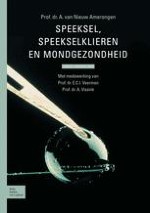2008 | OriginalPaper | Hoofdstuk
13 Speeksel en smaakgewaarwording
Auteur : Prof. dr. A. van Nieuw Amerongen
Gepubliceerd in: Speeksel, speekselklieren en mondgezondheid
Uitgeverij: Bohn Stafleu van Loghum
Samenvatting
-
Bij het merendeel van de patiënten met xerostomie treden klachten op over de smaakgewaarwording, hoewel er patiënten zijn met ernstige xerostomie zonder smaakklachten.
-
Vooral patiënten die cytostatica gebruiken, of die bestraald zijn in het hoofd-halsgebied, ondervinden hinderlijke smaakstoornissen door een direct effect van de ingestelde therapie op de smaakbekers en de verminderde speekselsecretie. In veel gevallen keert de smaakfunctie na enige tijd terug. De smaakgewaarwording kan wel blijvend zijn veranderd.
-
Vermindering van de smaakgewaarwording kan zijn gerelateerd aan verlaging van de zinkconcentratie in speeksel en in serum. Extra toevoeging van zink aan het dieet verbetert bij een deel van de patiënten de smaakfunctie.
-
Bij patiënten met hypogeusie kan verandering optreden in het zinkbevattende eiwit gustine en de prolinerijke eiwitten (PRP’s en bPRG). Onderzoek naar gustine suggereert dat de serumzinkspiegel in patiënten bepalend is voor de synthese en secretie van dit eiwit.
-
De moleculaire processen die betrokken zijn bij de transductie van een smaakstimulus in een neuronale stimulus, zijn mogelijk voor een deel analoog aan die bij bèta-adrenerge stimulatie van een perifere weefselcel: stimulatie van intracellulair adenylcyclase leidt tot verhoging van cAMP in de cel. Dit molecuul stimuleert een aantal biochemische processen, waaronder fosforylering van eiwitten. Dit zou kunnen leiden tot verandering van de Na+-geleiding over het synaptische membraan. Het Ca2+-bindende eiwit calmoduline speelt in dit proces een regulerende rol. Een smaakstimulus kan worden verlaagd door een verhoogde inactivering van cyclisch AMP onder invloed van fosfodi-esterase.
-
Aan het verlies van smaak- en reukfunctie liggen verschillende factoren ten grondslag. Het is moeilijk, zo niet onmogelijk, om eenduidig aan te geven in hoeverre bepaalde processen hierbij betrokken zijn. De meest universele stof voor de smaak- en reukgewaarwording is vermoedelijk zink.
